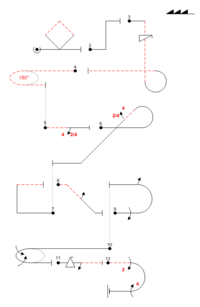Aresti symbol
An Aresti symbol is a standardized, schematic drawing of a single flight figure in competitive aerobatics such as B. a loop or a turn , which simplifies the movements of the aircraft .
- Solid lines indicate upright maneuvers or positive g-forces.
- Dashed lines indicate maneuvers flown on the back or negative g-forces.
- Triangles indicate stalled maneuvers (such as spinning , cracked and bumped rolls, etc.).
- Arrows indicate rolling maneuvers (possibly with numbers that stand for the expansion / segments of a role)
use
Aresti symbols are used both in specialist literature and by aerobatic pilots . They can be combined and strung together to form complete competition flight programs and are used for categorization and evaluation. They are designed in such a way that they always clearly define a figure. Aerobatic pilots use them on slips of paper attached to the pilot's cockpit to remind themselves of the flight program during the demonstration.
Each maneuver has a "K" factor, which stands for the degree of difficulty of an exercise. In a competition, the jury evaluates each maneuver with a value of up to 10 (as in other sports competitions). At the end, this value is multiplied by the “K” factor to calculate the number of points achieved.
But there are also numerous widespread aerobatic figures that do not have an Aresti symbol because they are not flown in competitive aerobatics, such as B. the barrel roll or all gyroscopic figures such as the Lomcovák .
history
They were introduced in 1961 by the Aerobatic Commission of the Fédération Aéronautique Internationale (FAI), the Commission Internationale de Voltige Aerienne ( CIVA ), at the suggestion of the Spanish delegate at the time, Count José Luis de Aresti Aguirre, as a catalog of the difficulty factors of the figures. The Aresti catalog is revised periodically.
copyright
For a while it was possible to download the complete Aresti catalog as a PDF file free of charge from the FAI website. After the Aresti family took legal action, the FAI had to remove the catalog from their side. Since then, it has again only been available in printed form and for a fee.
To this day there are differences of opinion as to which parts of the Aresti catalog are now protected by copyright (copyright by the Aresti family) and which are not. The problem is that even before Aresti, lines, arrows and triangles were used to put aerobatics on paper.
